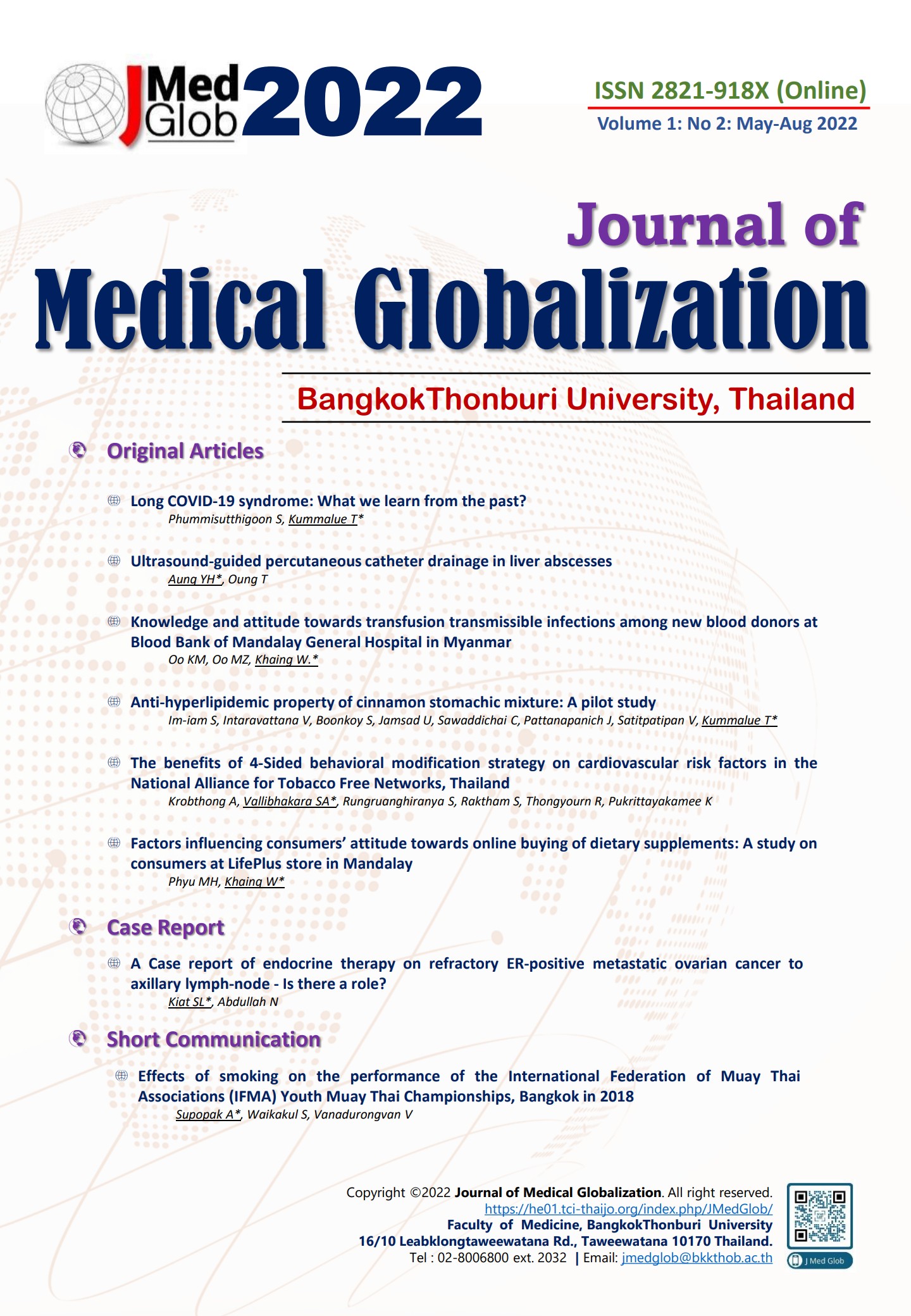Long COVID-19 syndrome: What we learn from the past?
Keywords:
complication, Long COVID, mechanisms, stage IV COVID-19Abstract
Many millions people worldwide has been suffering from an emerging highly contagious viral disease, COVID-19, in the Year 2019. Not only the acute phase or “early phase” can cause mortalities, but also the stage IV or “Long COVID phase” can cause morbidities in these groups of patients. To date, COVID-19 infected patients presented with “Long COVID phase” are rising all the time. At “Long COVID phase” (stage IV), various complications of the bodies’ systems are involved, such as pulmonary, cardiovascular, renal, neuropsychiatric, and gastrointestinal systems, etc. The mechanisms underlying these complications are not well established. However, recent reports demonstrated that the symptoms of the stage IV might be resulted from the abnormal immunities after the infection, especially the adaptive immune response. Thus, this prompted us to review the pathophysiology, risk factors, symptomatology and complications, including diagnosis and treatment of “Long COVID phase”.
References
Aiyegbusi O, Hughes S, Turner G, Riversa S, McMullan C, Chandan J, et al. Symptoms, complications and management of long COVID: A review. J Royal Soc Med. 2012;114(9):428-42.
Akbarialiabad H, Taghrir MH, Abdollahi A, Ghahramani N, Kumar M, Paydar S, et al. Long COVID, a comprehensive systemic scoping review. Infection. 2012;49:1163-86.
Yan Z, Yang M, Lai CL. Long COVID-19 syndrome: A comprehensive review of its effect on various organ systems and recommendation on rehabilitation plans. Biomedicines. 2012;9:966.
Yong SJ. Long COVID or post-COVID-19 syndrome: putative pathophysiology, risk factors and treatments. Infect Dis. 2012:1-18.
Sivan M, Taylor S. NICE guideline on long covid. BMJ. 2020. https://doi.org/10.1136/bmj.m4938.
Greenhalgh T, Knight, ACourt C, Buxton M, Husain L. Management of post-acute covid-19 in primary care. BMJ 2020;370:m3026.
Nalbandian A, Sehgal K, Gupta A, Madhavan M, McGroder C, Stevens JS, et al. Post-acute COVID-19 syndrome. Nat Med. 2012;27:601-15.
Staffolani S, Lencinella V, Cimatti M, Tavio M. Long COVID-19 syndrome as a fourth phase of SARS-CoV-2 infection. Le Infezioni Medicina. 2022;1:22-9.
Baig AM. Deleterious outcomes in Long-Hauler COVID-19: The effects of SARS-CoV-2 on the CNS in chronic COVID syndrome. ACS Chem Neurosci. 2020;11:4017-20.
Karlsson A, Humbert M, Buggert M. The known unknowns of T cell immunity to COVID-19. Sci Immuno. 2020;5(53).
Brodin P. Immune determinants of COVID-19 disease presentation and severity. Nat Med. 2012;27(1):28-33.
Sidarta D, Jara CP, Ferruzzi AJ, Skaf MS, Velander WH, Araujo EP, et al. Sars-cov-2 receptor is co-expressed with elements of the kinin-kallikrein, renin-angiotensin and coagulation systems in alveolar cells. Sci Rep. 2020;10:19522.
Raveendran AV, Jayadevan R, Sashidharan S. Long COVID: An overview. Diabetes India. 2021.
Zhao YM, Shang YM, Song WB, Li QQ, Xie H, Xu QF, et al. Follow-up study of the pulmonary function and related physiological characteristics of COVID-19 survivors three months after recovery. EClinicalMed. 25 (2020)100463.
Crook H, Raza S, Nowell J, Young M, Edison P. Long covid-mechanisms, risk factors, and management. BMJ. 2012;374:n1648.
Dixit N, Churchill A, Nsair A, Hsu J. Post-Acute COVID-19 syndrome and the cardiovascular system: What is known? Am Heart J Plus: Cardiol Res Prac. 2021;100025.
Dani A, Dirksen A, Taraborrelli P, Torocastro M, Panagopoulos D, Sutton R, et al. Autonomic dysfunction in “long COVID”: rationale, physiology and management strategies. Clin Med. 2021;21:e63-7.
Nordvig A, Fong K, Willey J, Thakur K, Boehme A, Vargas W, et al. Potential neurologic manifestations of COVID-19. Clin Prac. 2021;11.
Pavoni V, Gianesello L, Pazzi M, Stera C, Meconi T, Covani Frigieri F. Evaluation of coagulation function by rotation thromboelastometry in critically ill patients with severe COVID-19 pneumonia. J Thrombosis Thrombolysis.2020;50:281-6.
Zuo T, Zhang F, Lui G, Yeoh Y, Li A, Zhan H, et al. Alterations in gut microbiota of patients with COVID-19 during time of hospitalization. Gastroenterol. 2020;159:944-55.
National Institute for Health and Care Excellence (NICE), Scottish Intercollegiate Guidelines Network (SIGN), Royal College of General Practitioners (RCGP), COVID-19 rapid guideline: managing the long-term effects of COVID-19, NICE 2022;1:13.
Published
How to Cite
Issue
Section
License
Copyright (c) 2022 Journal of Medical Globalization

This work is licensed under a Creative Commons Attribution-NonCommercial 4.0 International License.








